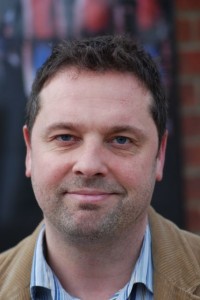Steve Boland, Director of Market Development at Presteigne Charter talks about their new 3D nightvision camera and his ideas about the future of 3D sport
 [Philip Lelyveld comment: this is a lengthy interview covering the technical and business side of 3D.]
[Philip Lelyveld comment: this is a lengthy interview covering the technical and business side of 3D.]
Steve Boland currently heads Presteigne Charter’s market development. The company boasts an extensive 3DTV project portfolio including a 3D multi-camera fly pack for MTV’s World Stage in Malaysia, Sony’s ‘Lens to living room’ live 3D production at IFA Berlin and single-camera 3D documentaries for Electric Sky.
In 2010, Steven Boland received a BAFTA nomination in the ‘New Media’ category along with the Sky Arts team and Antony Gormley for ‘One and Other’, a 24/7, 100-day live project in Trafalgar Square, London.
In this exclusive MIPTV interview, we start by asking Steve Boland what message he has for MIPTV delegates about Presteigne Charter’s strategy and ambitions.
Steve Boland: MIPTV is a very important event for 3DTV and it is encouraging to see the 3D conference 3D grow from last year. From a technology and support perspective, I think the industry has moved to an advanced stage in a very short period. There are now more intuitive tools than ever to create 3D and the cost of production is being reduced thanks to faster set up times and experienced crew. The challenge is to continue developing the creative language and engage viewers in new ways. Presteigne Charter remains committed to a long term view of 3D development and continues to invest in education, people and technology to support the format.
3D Focus: I understand you have been working on a night-vision 3D camera – can you elaborate?
Steve Boland: Presteigne Charter commissioned the build of a portable single-bodied 3D camera around 2.5 years ago. Called the RT-1000, the camera has been used extensively on 3D sports events since. We were approached by wildlife producers to look at ideas of translating 2D programmes to 3D. An area of interest was night filming. With software and control interface adjustments we were able to switch the camera remotely from colour day-mode to a monochrome night-mode. With minimal infrared lighting the camera can offer a surprising amount of detail in monochrome 3D. As the camera also operates wirelessly we are hoping the night vision feature may stimulate some creative ideas for factual or reality-style programming.
3D Focus: Is there an argument that 3D television could outshine 3D cinema as home screens get bigger and there is no ‘per viewer’ glasses premium anymore with passive sets?
Steve Boland: I think this will be driven largely by appropriate content for the viewing environment. Premium live events could benefit from larger screens at home and cheaper passive glasses. Getting people in front of TV screens at certain times is an on-going challenge, particularly against other media outlet options in the home. A shared experience that offers a closer viewer proximity to a live event is clearly attractive to both cinemas and television.
3D Focus: Live sport can include frequent edge violations, sun flare issues and sports men and women suddenly appearing very close to the camera creating extreme uncomfortable negative parallax. In a live scenario, when there are no post fixes available, will these problems always exist? Should live 3D streams be slightly delayed?
....
See the full story here: